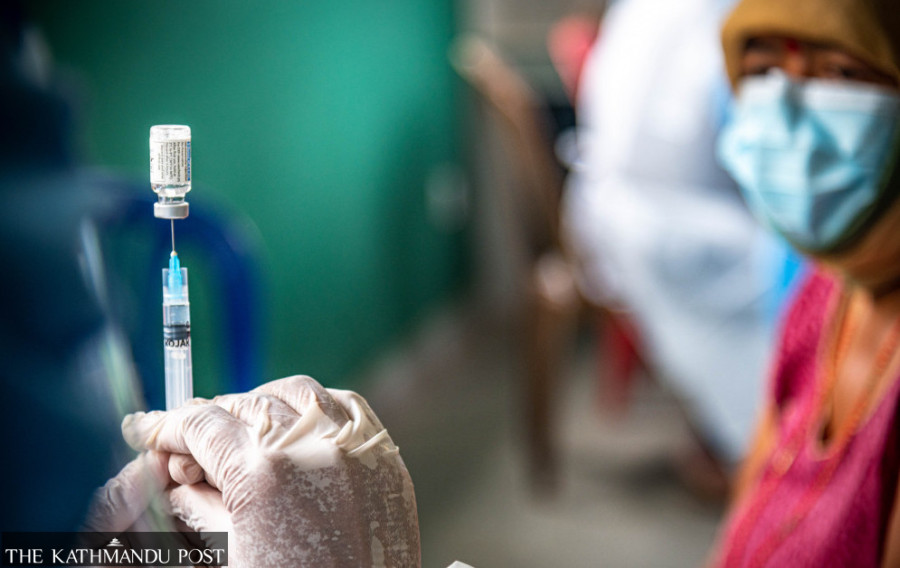Health
Nepal on track to vaccinate its eligible population as more jabs are on way
34 million doses are in pipeline—most due to arrive by the year’s end. Public health experts stress need for improving storage and supply systems and scaling up vaccination.
Arjun Poudel
After a brief setback, Nepal by and large has managed to secure Covid-19 vaccine doses on a regular basis to continue its vaccination campaign. And with some new deals the government has signed, along with the promises to provide the jabs in grants, the country is set to receive enough doses to inoculate the rest of the targeted population.
According to officials, over 34 million doses of different types of vaccines will arrive in the country within two months.
“Of the over 34 million doses that Nepal is set to receive, some the government has purchased and others will be provided by COVAX,” said Dr Bibek Kumar Lal, director at the Family Welfare Division under the Department of Health Services, told the Post.
According to officials, COVAX, the international vaccine-sharing scheme backed by the United Nations, will supply 2,188,800 doses of single-shot Janssen, 3,712,000 doses of Moderna vaccine and 3,364,000 doses of AstraZeneca.
All the said doses are scheduled to arrive by December this year.
Apart from this, the COVAX facility is also providing 6,039,000 doses of AstraZeneca and the shipment is expected within December.
The facility last week provided 492,000 doses of AstraZeneca, which arrived along with 144,000 doses provided by the Switzerland government.
China is providing 3 million doses of the Sinovac vaccine which is scheduled to arrive within this month.
The government has also purchased 5,936,400 doses of Vero Cell under the COVAX facility’s cost-sharing scheme, with the loan provided by the Asian Development Bank. Of the 5,936,400 doses, the facility has already delivered 2,078,000 doses. A consignment of the remaining doses is likely to arrive within December.
Nepal has also signed concessional loan agreements with multilateral funding agencies like the Asian Development Bank and the World Bank as part of their support to Nepal’s resilient recovery from the Covid-19 pandemic.
In August, the Asian Development Bank and the Nepal government signed a $165 million (nearly Rs20 billion) loan agreement to purchase vaccines against Covid-19.
The government has also purchased additional 500,000 doses of Vero Cell vaccine through the COVAX cost-sharing scheme using Asian Development Bank’s loan. The doses are scheduled to arrive within the first quarter of 2022.
Authorities have also purchased 4 million doses of Moderna vaccine from the Asian Development Bank’s loan, also through COVAX’s cost-sharing scheme. The doses are expected to be delivered within the first quarter of 2022.
Moreover, the government has bought 6 million doses of Pfizer-BioNTech vaccine from the US using the World Bank’s loan.
“We have been assured that most of the doses will be delivered within Q4 (the fourth quarter) or within December,” said Lal. “The vaccine we have bought from the US and through COVAX will start arriving from December.”
Public health experts have hailed that more vaccines are arriving but they say authorities need to focus on proper management and storage while scaling up the vaccination drive.
“If all the doses arrive by the said time frame, Nepal will have more than enough doses to vaccinate all eligible people,” said Dr Shyam Raj Upreti, coordinator of the Covid-19 Vaccine Advisory Committee. “Authorities should speed up the vaccination drive. They also need to manage storage and improve the supply system.”
Nepal aims to administer Covid-19 jabs to all eligible populations by mid-April next year. It needs to vaccinate around 78 percent of its 30 million population—or around 25 million people, as per the government’s new plan that also includes those aged between 12 and 18 years. The government earlier planned to vaccinate only those aged 15 years and above.
Since around 4-5 million Nepalis are said to be living abroad, around 19-20 million people need to be vaccinated. For this, the country needs a little over 40 million doses of double-shot vaccines.
Nepal launched its vaccination drive on January 27 this year, becoming one of the first countries to inoculate its population against Covid-19. The campaign was kicked off after India provided 1 million doses of Covishield, the AstraZeneca type of vaccine manufactured by Serum Institute of India, in grant support. Nepal also paid for 2 million doses, but after supplying half of the order, Serum expressed its inability to deliver the doses citing vaccine shortage in India, which was hit by a second wave. The remaining doses were shipped only recently on October 9.
With the government failing to secure doses, the vaccination campaign was hit hard. However, the jabs started to arrive again after countries like China, Japan, Bhutan and the United States started shipping the consignments. Nepal has also received vaccine doses from the Maldives.
As of Monday, 11,478 people have died of Covid-19 across the country since the pandemic began. Lately, the number of cases has sharply come down. In the last 24 hours, according to the Health Ministry, 416 people tested positive for the coronavirus. Only one death was reported. The number of active cases stands at 7,311 throughout the country.
Nepal so far has received 22,571,810 doses of Covid-19 vaccines–Vero Cell, AstraZeneca, Janssen and Pfizer-BioNTech.
As of Monday, 7,580,113 people (25 percent of the total population) have been fully vaccinated, according to the Health Ministry.




 7.12°C Kathmandu
7.12°C Kathmandu













%20(1).jpg&w=300&height=200)
